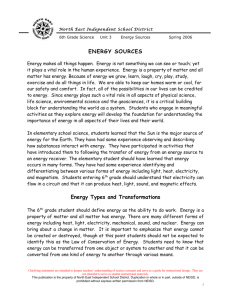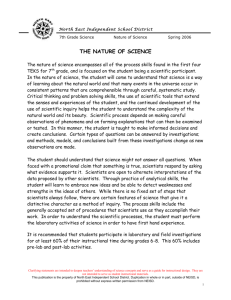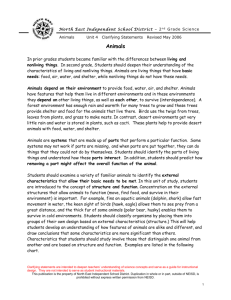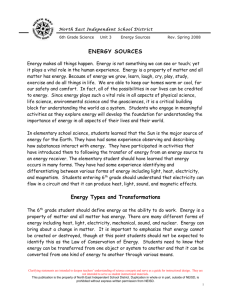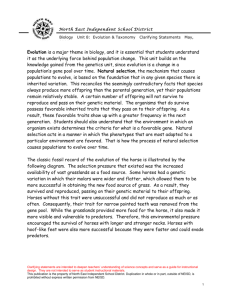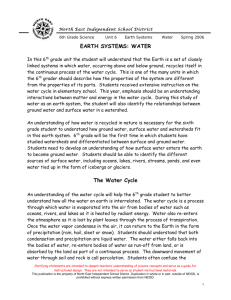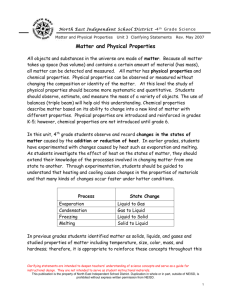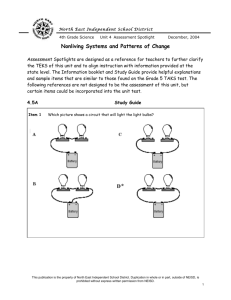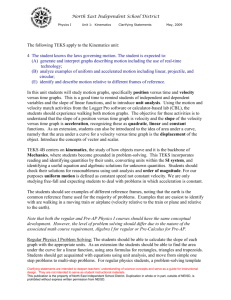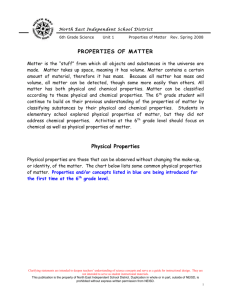6th Grade Science: Force and Motion Unit Plan
advertisement
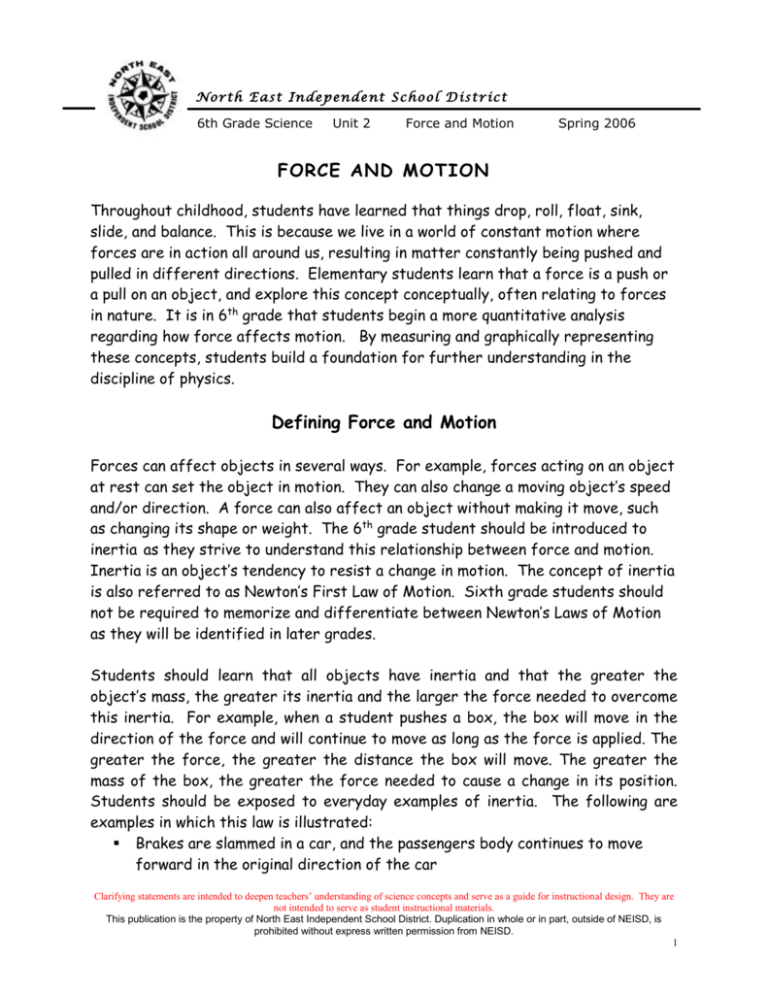
N o r th E a s t In d e pen d e nt S c ho o l Di s tr ic t 6th Grade Science Unit 2 Force and Motion Spring 2006 FORCE AND MOTION Throughout childhood, students have learned that things drop, roll, float, sink, slide, and balance. This is because we live in a world of constant motion where forces are in action all around us, resulting in matter constantly being pushed and pulled in different directions. Elementary students learn that a force is a push or a pull on an object, and explore this concept conceptually, often relating to forces in nature. It is in 6th grade that students begin a more quantitative analysis regarding how force affects motion. By measuring and graphically representing these concepts, students build a foundation for further understanding in the discipline of physics. Defining Force and Motion Forces can affect objects in several ways. For example, forces acting on an object at rest can set the object in motion. They can also change a moving object’s speed and/or direction. A force can also affect an object without making it move, such as changing its shape or weight. The 6th grade student should be introduced to inertia as they strive to understand this relationship between force and motion. Inertia is an object’s tendency to resist a change in motion. The concept of inertia is also referred to as Newton’s First Law of Motion. Sixth grade students should not be required to memorize and differentiate between Newton’s Laws of Motion as they will be identified in later grades. Students should learn that all objects have inertia and that the greater the object’s mass, the greater its inertia and the larger the force needed to overcome this inertia. For example, when a student pushes a box, the box will move in the direction of the force and will continue to move as long as the force is applied. The greater the force, the greater the distance the box will move. The greater the mass of the box, the greater the force needed to cause a change in its position. Students should be exposed to everyday examples of inertia. The following are examples in which this law is illustrated: Brakes are slammed in a car, and the passengers body continues to move forward in the original direction of the car Clarifying statements are intended to deepen teachers’ understanding of science concepts and serve as a guide for instructional design. They are not intended to serve as student instructional materials. This publication is the property of North East Independent School District. Duplication in whole or in part, outside of NEISD, is prohibited without express written permission from NEISD. 1 N o r th E a s t In d e pen d e nt S c ho o l Di s tr ic t 6th Grade Science Unit 2 Force and Motion Spring 2006 A table cloth is quickly pulled out from under dishes, and they stay in place Objects that come in contact with each other exert a force on each other. For example, when a book is placed on a table, the book exerts a force on the table and the table exerts a force on the book. In addition, every force has a certain strength, or magnitude, and a direction. A rock on the ground exerts a force on the ground equal to its weight in a downward direction. Forces can affect objects in several ways. They can set a stationary object in motion, they can change an object’s speed or direction, and can even change an object’s shape. Motion is the change in position of an object. Changing position and recognizing motion is not as easy as it sounds. Motion is relative. Reference points are needed to describe the motion. The location of an object is how far the object is located from the reference point (also known as the position of the object). Some familiar reference points include north, south, east, west, up, and down. Forces that Affect Motion Sixth grade students need to begin to develop an understanding of gravity as a force of attraction between objects that have mass. Since all matter has mass, students should understand that gravity acts as a force between all objects. The strength of the gravity between two objects depends on the mass of the objects and the distance between them. This concept should also be explored when students learn about the components of our solar system later in the year. When using the term mass of an Clarifying statements are intended to deepen teachers’ understanding of science concepts and serve as a guide for instructional design. They are not intended to serve as student instructional materials. This publication is the property of North East Independent School District. Duplication in whole or in part, outside of NEISD, is prohibited without express written permission from NEISD. 2 N o r th E a s t In d e pen d e nt S c ho o l Di s tr ic t 6th Grade Science Unit 2 Force and Motion Spring 2006 object, it is always a good idea to check for misconceptions. Make sure students are not confusing mass with weight. Mass is a property of an object and does not depend on an object’s location. Weight is a measure of the force of gravity acting on an object. It can vary depending on the object’s location. Students should be reminded that their body would have the same mass whether they were on Earth or on the moon. The body’s weight on the moon would be less because the moon’s gravity is less than Earth’s gravity since the moon is smaller than Earth. Other forces that affect motion include magnetism and electricity. Students can discover how these forces affect motion by exploring with magnets and with static electricity. Both magnetism and electricity are caused by positive and negative charges in matter. Simple experimentation with magnets and small magnetic objects such as paper clips demonstrate the push and pull of magnetism. Rubbing a balloon with a piece of wool and watching its effect on another balloon and other items also demonstrates the push and pull force of electricity in a safe way. They should determine that like gravity, magnetic and electric forces decrease with distance. Students should have the opportunity to experiment with friction. Friction is a force that opposes the motion between two surfaces that are in contact with each other. Friction might prevent motion from starting or it might oppose motion in progress. There are different types of friction, classified as sliding, rolling and fluid friction. Students should be exposed to examples of each type, but they do not need to learn these terms or classify according to type. It is more important that they have a conceptual understanding that friction can occur in many different ways or situations. This should also include an understanding that friction does not have to occur between two solid objects, but can occur as objects move through liquids and gases as well. Students sometimes view friction as a negative or undesirable force that opposes motion. As a result, it is important for students to understand that friction can be very helpful, such as when brakes are applied to stop a car. Students should be able to recognize examples of friction in everyday life. The following are some examples: a book sliding across a desk a car’s wheels rolling on the ground an airplane moving through the air a swimmer moving through a pool of water Clarifying statements are intended to deepen teachers’ understanding of science concepts and serve as a guide for instructional design. They are not intended to serve as student instructional materials. This publication is the property of North East Independent School District. Duplication in whole or in part, outside of NEISD, is prohibited without express written permission from NEISD. 3 N o r th E a s t In d e pen d e nt S c ho o l Di s tr ic t 6th Grade Science Unit 2 Force and Motion Spring 2006 Describing Motion Motion can be described in many ways. How fast did an object go? How far did an object go? Where did the object go? Did the object slow down or speed up? Did it turn to the left or right? Speed is the distance traveled by an object in a given amount of time (s = d /t). Velocity is described as the speed of an object in a given direction. An example would be a plane traveling 600 km/hr in a westward direction. Acceleration is any change in speed or direction (velocity) over time. Students should practice calculating speed, velocity and acceleration. The formula for speed appears on the TAKS formula chart, indicating it can be tested. Acceleration appears on the formula chart as part of the formula for force, a calculation that will be performed in 7th grade. Calculating acceleration by itself builds the foundation for understanding the equation for calculating force next year. It should also be noted that students do not need to be able to manipulate formulas to solve for other variables. For example, the 6th grade student needs to be able to use the formula s= d /t to solve for speed but not to solve for distance or time. The following formulas should be utilized in this unit: speed = distance / time velocity = distance / time (in a particular direction) acceleration = (final velocity – starting velocity) / time it takes to change velocity Force is measured in units called Newtons (N) and should be measured with a spring scale. At any given time, more than one force acts on an object. Forces might be applied in the same direction, such as when two people work together to move an object. Forces might be applied to work against each other, such as in tug-o-war. The net force on an object is the combination of all of the forces acting on it. When the net force on an object is zero, the forces are balanced and there is no change in motion. When the net force on an object is greater than zero, the forces are said to be unbalanced. Unbalanced forces produce a change in the motion of an object. Clarifying statements are intended to deepen teachers’ understanding of science concepts and serve as a guide for instructional design. They are not intended to serve as student instructional materials. This publication is the property of North East Independent School District. Duplication in whole or in part, outside of NEISD, is prohibited without express written permission from NEISD. 4 N o r th E a s t In d e pen d e nt S c ho o l Di s tr ic t 6th Grade Science Unit 2 Force and Motion Spring 2006 Students should practice finding the net force in various situations. Forces can be represented by arrows as shown in the illustrations below. Arrows show direction. The length of an arrow and/or numbers that accompany the arrows show magnitude. The width of an arrow should not be used to indicate the magnitude of a force. When the forces are acting together, students will simply add them together. + = net force Two forces combine to produce a larger force. This is called having an overall “net force”. Clarifying statements are intended to deepen teachers’ understanding of science concepts and serve as a guide for instructional design. They are not intended to serve as student instructional materials. This publication is the property of North East Independent School District. Duplication in whole or in part, outside of NEISD, is prohibited without express written permission from NEISD. 5 N o r th E a s t In d e pen d e nt S c ho o l Di s tr ic t 6th Grade Science Unit 2 Force and Motion Spring 2006 When forces are moving in opposite directions, students will subtract the smaller force from the larger one to find the net force. + = net force Two forces subtract from each other, and it causes movement in the direction of the larger force. Two equal forces pushing against one another in opposite directions will cancel each other out and no movement will occur. net force + = 0 Balanced forces = net force of zero Note: These skaters are in a state of equilibrium, and movement is not occurring. Clarifying statements are intended to deepen teachers’ understanding of science concepts and serve as a guide for instructional design. They are not intended to serve as student instructional materials. This publication is the property of North East Independent School District. Duplication in whole or in part, outside of NEISD, is prohibited without express written permission from NEISD. 6 N o r th E a s t In d e pen d e nt S c ho o l Di s tr ic t 6th Grade Science Unit 2 Force and Motion Spring 2006 Changes in motion can be represented on a graph. Students should have practice in constructing and interpreting graphs that represent changes in motion. A distancetime graph can be used to represent an object’s movement. Time is measured on the x axis (horizontal axis) and distance is measured on the y axis (vertical axis). Units for time and distance should be in metric units, such as seconds, minutes, meters, centimeters, etc. On this type of graph, the steepness of the slope of the line is directly proportional to the speed of an object. Horizontal lines represent a stop in motion. Examples of such graphs are as follows: Graph representing constant speed Distance in meters 0 1 2 3 4 5 6 7 8 9 Time in seconds 10 11 12 Graph representing constant speed followed by a stop Distance in meters 0 1 2 3 4 5 6 7 8 9 Time in seconds 10 11 12 Clarifying statements are intended to deepen teachers’ understanding of science concepts and serve as a guide for instructional design. They are not intended to serve as student instructional materials. This publication is the property of North East Independent School District. Duplication in whole or in part, outside of NEISD, is prohibited without express written permission from NEISD. 7
